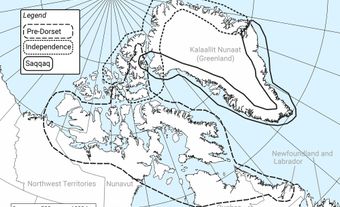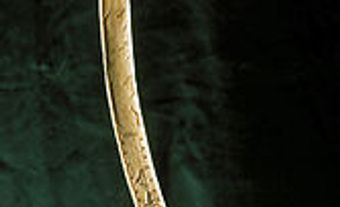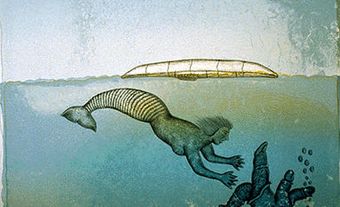Around 2,800 years ago (ca. 800 BCE), the Palaeo-Inuit groups living in the Eastern North American Arctic began to drastically change. These later Palaeo-Inuit groups are collectively called the “Dorset” by archaeologists. They had many differences from their Pre-Dorset ancestors. The Dorset people would persist in the Arctic until roughly 600-700 years ago (ca. 1300-1400 CE). After this point, they disappeared. This happened only a few centuries after the arrival of early Inuit (Thule) groups. They were genetically and culturally distinct from the Dorset.
Archaeologists separate this roughly 2,000-year period of Dorset existence into three different periods or traditions. These periods are the Early Dorset (ca. 800 BCE to 1 CE), Middle Dorset (ca. 1 to 500 CE) and Late Dorset (ca. 500 to 1400 CE). There is ongoing debate regarding the differences and similarities between these time periods. However, changes in terms of technology, domestic architecture, mobility and geographic range did occur (see also Dorset Culture).

Timing and Geographic Distribution
The timing and nature of the Pre-Dorset to Dorset transition is heavily debated. Initially, some archaeologists argued it was a gradual process. Some sites represented a “transitional” period. At these sites, people had some elements of Pre-Dorset and Dorset material culture. However, modern research has shown that the transition may have been more rapid. Many of these “transitional” sites are a mixture of two distinct occupations, first by the Pre-Dorset and centuries later by the Dorset.
The earliest Dorset sites date to between 800 to 500 BCE. This is considered the start of the Early Dorset period. Early Dorset groups existed throughout the Eastern North American Arctic from Victoria Island in the west to Labrador in the east and Ellesmere Island in the north. Some Dorset groups also lived throughout coastal Greenland. These are often called the Greenlandic Dorset by archaeologists to reflect their unique nature. There also exists a related group called the Groswater Palaeo-Inuit. This group shares similarities with both Pre-Dorset and Dorset. However, they existed solely in Labrador, Newfoundland and parts of Nunavik.

At some point around the start of the Common Era (1 CE), the Dorset began to change where they lived. Dorset groups abandoned Greenland and the High Arctic. Archaeologists have called this period the Middle Dorset period. Some archaeologists consider Early and Middle Dorset material culture similar. However, this was a time when their exchange networks were more regional and did not extend as far as they once did. Despite this overall decrease in where they lived, some Dorset groups moved to new areas, such as Newfoundland. The cause for this shift in geographic location is debated by archaeologists but may be, in part, due to a cooling climate.

Around 500 CE, the Dorset experienced a significant shift. They expanded their exchange networks and traded materials, knowledge and ideas across the entirety of the Eastern North American Arctic. This fluorescence of Dorset life and interconnectivity is called the Late Dorset period by archaeologists. This was a time when there is a significant amount of evidence for interaction between Dorset groups. Furthermore, Late Dorset groups reoccupied parts of the High Arctic and northern Greenland starting around 700 CE. However, despite this expansion of where they lived during this period, the Dorset also entirely disappeared from Newfoundland and much of central and southern Labrador.

Around 1000 CE, the Dorset began to abandon some parts of the Arctic. They entirely disappeared at some point between 1300 and 1400 CE. The cause for this relatively sudden disappearance is heavily debated by archaeologists. There are no known genetic descendants of the Dorset. This makes the issue even harder to understand. Furthermore, there is little evidence of conflict between the Dorset and other northern groups, such as the Inuit and Dene. As a result, their disappearance is even more confounding. However, there is overlap of the latest Dorset and earliest Inuit in some parts of the Arctic. The instances of interaction described in oral histories between the Inuit and the Tuniit, a people that closely resemble what archaeologists have labelled as “Dorset,” suggest some amount of contact between the two groups. Whether or not this relates to the fate of the Dorset is unknown.

 Share on Facebook
Share on Facebook Share on X
Share on X Share by Email
Share by Email Share on Google Classroom
Share on Google Classroom




